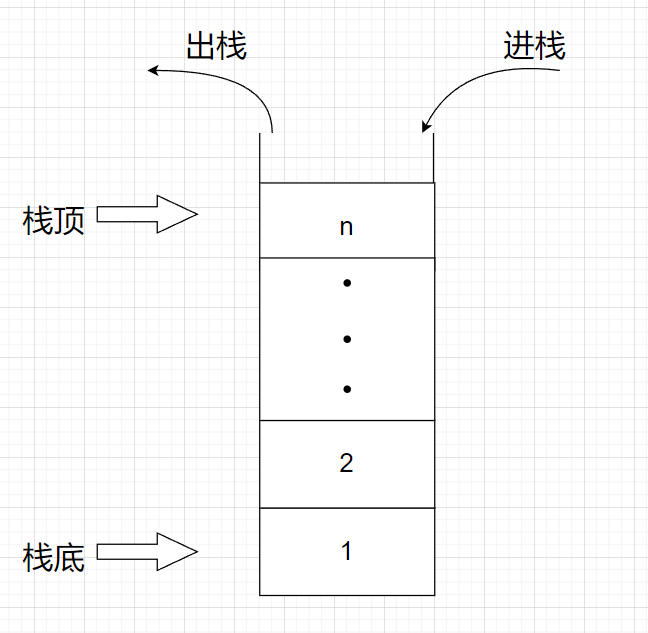前一段时间,我们试着用C语言实现了数据结构中的顺序表,单链表,双向循环链表。今天我们再用C语言来实现另一种特殊的线性结构:栈
栈(stack)又名堆栈,它是一种运算受限的线性表。限定仅在表尾进行插入和删除操作的线性表。这一端被称为栈顶,相对地,把另一端称为栈底。向一个栈插入新元素又称作进栈、入栈或压栈,它是把新元素放到栈顶元素的上面,使之成为新的栈顶元素;从一个栈删除元素又称作出栈或退栈,它是把栈顶元素删除掉,使其相邻的元素成为新的栈顶元素。
类似于步枪的子弹夹,后进去的子弹先发射出来以后,前面的子弹才可以发射。

前一段时间,我们学习了两种线性表,一种是顺序表,一种是链表,那么对于栈我们该用哪一个来实现比较好呢
首先我们来对比一下线性表和链表
| 不同点 | 顺序表 | 链表 |
|---|---|---|
| 存储空间上 | 物理上一定连续 | 逻辑上连续,但物理上不一定连续 |
| 随机访问 | 可以直接访问任何元素 | 必须从头节点开始往后寻找 |
| 任意位置插入或删除元素 | 要搬移其他的元素,效率低。 | 只需要修改节点的指针指向,效率高 |
| 插入 | 动态顺序表,当空间不够时需要扩容 | 无容量概念,需要就申请,不用就释放 |
| 应用场景 | 元素高效存储,并且需要频繁访问 | 需要在任意位置插入或者删除频繁 |
综合以上来看,我认为实现一个栈,使用顺序表比较好。
1.栈是先进后出,使用顺序表,在元素出栈后更容易找到新的栈顶。
2.顺序表CPU高速缓存命中率高,可以减少CPU去内存拿数据的次数,速度快,效率高。
1.包含的标准库
#include <stdio.h> #include <stdlib.h> #include <stdbool.h> //C语言中的bool类型需要这个头文件 #include <assert.h>
2.定义结构体
typedef int STDateType;//栈中元素的数据类型
typedef struct Stack
{
STDateType* a; //顺序表
int top; //栈顶
int capacity; //栈的容量
}Stack;
3.函数的声明
void StackInti(Stack* ps); // 栈的初始化 void StackDestory(Stack* ps); // 栈的销毁 void StackPush(Stack* ps, STDateType x); // 入栈 void StackPop(Stack* ps); // 出栈 bool StackEmpty(Stack* ps); // 判断栈是否为空 STDateType StackTop(Stack* ps); // 取栈顶元素
1. 栈的初始化
我们用assert(断言),防止ps为空指针。
void StackInti(Stack* ps)
{
assert(ps);
ps->a = NULL;
ps->capacity = 0;
ps->top = 0;
}
2. 栈的销毁
释放顺序表。
void StackDestory(Stack* ps)
{
assert(ps);
free(ps->a);
ps->capacity = 0;
ps->top = 0;
}
3.入栈
void StackPush(Stack* ps, STDateType x)
{
assert(ps);
if (ps->top == ps->capacity) //判断容量是否足够
{
int newCapcity = ps->capacity == 0 ? 4 : ps->capacity * 2;
ps->a = (int*)realloc(ps->a, sizeof(int) * newCapcity);
if (ps->a == NULL)
{
printf("ralloc error");
exit(-1);
}
ps->capacity = newCapcity;
}
ps->a[ps->top] = x;
ps->top++;
}

4. 出栈
void StackPop(Stack* ps)
{
assert(ps);
assert(ps->top > 0); //空栈不能被删除
ps->top--;
}
5. 判断栈是否为空
bool StackEmpty(Stack* ps)
{
assert(ps);
return ps->top == 0; // 如果为空则返回true,否则返回false
}
6. 取栈顶元素
STDateType StackTop(Stack* ps)
{
assert(ps);
assert(ps->top > 0);//空栈不能被删除
return ps->a[ps->top - 1];
}
这样我们就实现了一个简单的栈
#include <stdio.h>
#include <stdlib.h>
#include <stdbool.h>
#include <assert.h>
typedef int STDateType;
typedef struct Stack
{
STDateType* a;
int top;
int capacity;
}Stack;
void StackInti(Stack* ps)
{
assert(ps);
ps->a = NULL;
ps->capacity = 0;
ps->top = 0;
}
void StackDestory(Stack* ps)
{
assert(ps);
free(ps->a);
ps->capacity = 0;
ps->top = 0;
}
void StackPush(Stack* ps, STDateType x)
{
assert(ps);
if (ps->top == ps->capacity)
{
int newCapcity = ps->capacity == 0 ? 4 : ps->capacity * 2;
ps->a = (int*)realloc(ps->a, sizeof(int) * newCapcity);
if (ps->a == NULL)
{
printf("ralloc error");
exit(-1);
}
ps->capacity = newCapcity;
}
ps->a[ps->top] = x;
ps->top++;
}
void StackPop(Stack* ps)
{
assert(ps);
assert(ps->top > 0);
ps->top--;
}
bool StackEmpty(Stack* ps)
{
assert(ps);
return ps->top == 0;
}
STDateType StackTop(Stack* ps)
{
assert(ps);
assert(ps->top > 0);
return ps->a[ps->top - 1];
}
我们好不容易实现了一个栈,接下来我们来做个题看看栈有什么用吧。
题目描述
给定一个只包括 ‘(’,’)’,’{’,’}’,’[’,’]’ 的字符串 s ,判断字符串是否有效。
有效字符串需满足:
左括号必须用相同类型的右括号闭合。
左括号必须以正确的顺序闭合。
基础框架
C语言的基础框架如下
bool isValid(char * s){
}
解题思路
左括号一定要和右括号对齐,非常满足栈的特性
我们可以将所有的左括号存入一个栈中。
然后遇到右括号,就出栈,判断是否匹配。
直到栈为空且字符串中的括号也遍历完了,那么所有括号就正确的匹配了。
代码详解
// 1.因为C语言并没有现成的栈,所以我们需要自己造轮子,先写个栈再说
typedef char STDateType; // 更改数据类型为char
typedef struct Stack
{
STDateType* a;
int top;
int capacity;
}Stack;
void StackInti(Stack* ps)
{
assert(ps);
ps->a = NULL;
ps->capacity = 0;
ps->top = 0;
}
void StackDestory(Stack* ps)
{
assert(ps);
free(ps->a);
ps->capacity = 0;
ps->top = 0;
}
void StackPush(Stack* ps, STDateType x)
{
assert(ps);
if (ps->top == ps->capacity)
{
int newCapcity = ps->capacity == 0 ? 4 : ps->capacity * 2;
ps->a = (int*)realloc(ps->a, sizeof(int) * newCapcity);
if (ps->a == NULL)
{
printf("ralloc error");
exit(-1);
}
ps->capacity = newCapcity;
}
ps->a[ps->top] = x;
ps->top++;
}
void StackPop(Stack* ps)
{
assert(ps);
assert(ps->top > 0);
ps->top--;
}
bool StackEmpty(Stack* ps)
{
assert(ps);
return ps->top == 0;
}
STDateType StackTop(Stack* ps)
{
assert(ps);
assert(ps->top > 0);
return ps->a[ps->top - 1];
}
bool isValid(char * s){
Stack a;
StackInti(&a);
while(*s)
{
if (*s == '(' || *s == '[' || *s == '{') //入栈
{
StackPush(&a, *s);
}
else //出栈
{
if(StackEmpty(&a)) //右括号多一个的情况
{
return false;
}
char tmp = StackTop(&a);
StackPop(&a);
if ((*s == ')' && tmp != '(')
||(*s == ']' && tmp != '[')
||(*s == '}' && tmp != '{') )
{
return false;
}
}
s++;
}
return StackEmpty(&a); //防止出现多一个左括号的情况
}